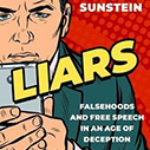The Perilous Public Square: Structural Threats To Free Expression Today

Editor: David E. Pozen
Publisher: New York, NY: Columbia University Press, 2020. 408p.
Reviewer: Clay Calvert | September 2021
Slightly more than 200 pages deep into this valuable collection of seven scholarly essays and accompanying response pieces that address multiple problems plaguing our free-speech ecosystem, one comes across a simple sounding yet substantively profound observation by Danielle Keats Citron. A 2019 MacArthur Fellow and current professor of law at the University of Virginia, Citron asserts that “[w]e have come to an important inflection point. The public is beginning to understand the extraordinary power that platforms wield over our lives. . . . Their terms-of-service agreements and content moderation systems determine if content is seen or heard or if it is muted or blocked” (p. 205).
If the public failed to grasp that proposition when this book was published in 2020, then it certainly should have learned it on January 8, 2021. That is when the President of the United States—ostensibly one of the most powerful people in the free world—was permanently suspended from Twitter. In banning then-President’s Donald J. Trump’s @realDonaldTrump account, Twitter cited “the risk of further incitement of violence” in the aftermath of the deadly riot two days earlier at the U.S. Capitol Building, which had followed closely on the heels of a Trump speech and rally near the White House.
While Trump’s loyalists vehemently argued that Twitter’s deplatforming of the nation’s forty-fifth president violated the guarantee of free speech enshrined for 230 years in the First Amendment to the U.S. Constitution, they were unmistakably wrong. Why? Because the First Amendment only guards against censorship by government entities and government officials, not censorship by private individuals and businesses such as Twitter, Facebook, YouTube, and Google. Trump, who thrived on aggressive and often outlandish tweets, learned the hard way that the First Amendment could not save his account. As Justice Brett Kavanaugh encapsulated it in the U.S. Supreme Court’s 2019 opinion in Manhattan Community Access Corp. v. Halleck, “[t]he Free Speech Clause does not prohibit private abridgment of speech.”
Halleck actually taps into some of the very same issues tackled in The Perilous Public Square: Structural Threats to Free Expression Today—namely, the limits of the First Amendment protection of freedom of speech, the current metes and bounds of the state action doctrine, and the nature of modern-day public forums for expression. The essays in this book, however, all predate Halleck. Specifically, they were first published on the website of the Knight First Amendment Institute at Columbia University from September 2017 through October 2018 as a series of papers regarding emerging threats to what Professor David E. Pozen, the editor of both the papers and this book version, aptly refers to as the “system of free expression” (p. 3).
The system of free expression, as that phrase is used in this book, is not narrowly confined to either the legal system or to the actions of government entities that are bound by the First Amendment’s strictures. Rather, it sweeps up the actions, algorithms, architecture, and policies of powerful social media platforms, as well as the individual actors, troll armies, and even nations that exploit those platforms for their own, often nefarious and self-serving, purposes.
This is not to say, however, that legal issues are not carefully and thoroughly addressed in this volume. For example, the pros and cons of the federal statutory protection afforded to the likes of Twitter, Airbnb, and Facebook by Section 230 of the Communications Decency Act of 1996 are explored in detail. Section 230 generally shields those entities and other interactive computer services from liability for content generated and posted by third parties. While that statute may have allowed the internet to grow by leaps and bounds, Professor Olivier Sylvain’s essay stresses how it also has allowed nonconsensual pornography (a subset of which is perhaps better known as revenge pornography) to flourish, along with other forms of cyber harassment, in an “unforgiving ecology” that stifles the speech of its victims, who often are women and minorities (p. 187). His essay and the responses that follow it, including one by Professor Citron noted at the start of this review, are incredibly timely. That’s because Congressional efforts to chip away at the immunity provided by Section 230 are likely to arise throughout President Joe Biden’s time in the Oval Office.
If the system of free expression, however, refers to more than just the legal system, then so too does the term “public square” in this tome’s title refer to far more than just traditional physical places and geographic spaces such as public parks, streets, and sidewalks. Indeed, Heather Whitney’s essay on the usefulness or lack thereof of deploying legal analogies to address, for purposes of First Amendment protection, the nature of the output and the control exerted by search engines (including Google’s autocomplete function that occurs when one begins to type a word or phrase into the search box) examines Justice Anthony Kennedy’s dicta in Supreme Court’s 2017 majority opinion in Packingham v. North Carolina. Kennedy asserted in Packingham that “[w]hile in the past there may have been difficulty in identifying the most important places (in a spatial sense) for the exchange of views, today the answer is clear. It is cyberspace—the ‘vast democratic forums of the internet’ in general . . . and social media in particular.” In other words, social media platforms are modern-day public squares.
This analogy, of course, leads to a macro-level question: Should private social media platforms be subject to greater government regulation, perhaps akin to the way that the Federal Communications Commission requires over-the-air broadcasters to serve the public interest, convenience, and necessity? Professor Tim Wu addresses this possibility in the book’s opening and most reader-friendly essay, as well its most wide-ranging and thought-provoking one, touching on everything from cheap speech to attentional scarcity to fake news to troll armies to company towns. Wu raises the issue of whether an entity such as the FCC might enforce against online social media platforms a version of the Fairness Doctrine that it once imposed on broadcasters. The Fairness Doctrine required broadcasters to cover issues of public concern and, when doing so, to fairly cover them by addressing conflicting viewpoints on the issues at hand. The Supreme Court upheld the Fairness Doctrine against a First Amendment challenge in 1969 in a case called Red Lion Broadcasting Co. v. FCC. The FCC later stopped enforcing the policy in the late 1980s. Red Lion itself, however, has never been overruled. Although Wu notes that he personally opposes imposing a Fairness Doctrine on social media platforms, the possibility cannot be ruled out, particularly as the immense power of platforms draws greater Congressional scrutiny.
Wu may actually have the ability to help institute some of the potential reforms now being discussed regarding social media platforms and so-called Big Tech. That is because President Joe Biden appointed Wu as an advisor in March 2021. White House Press Secretary Jen Psaki stated at the time that Wu “will help advance the president’s agenda, which includes addressing the economic and social challenges posed by the growing power of tech platforms, promoting competition and addressing monopoly and market power issues.” In brief, Wu’s appointment provides another important reason to pay special attention to his chapter in The Perilous Public Square.
Despite much of the book’s focus on the internet and social media platforms, Professor Frederick Schauer’s essay on First Amendment principles affecting hostile audience reactions to offensive and provocative speakers is grounded in real-world settings such as Charlottesville, Virginia, where the Unite the Right rally in 2017 turned deadly. While the tenet of guarding against a heckler’s veto that silences a controversial speaker seems well established in First Amendment jurisprudence, Schauer points out that much in this realm remains unsettled. For instance, he notes that “what is importantly not clear is just how much the authorities must do before taking some sort of action against the speaker or before bringing the entire event to a halt” (p. 73). Must, for instance, local law enforcement authorities be required to call in regional and state reinforcements if they feel it may be needed to quell violence? How much money must be spent in the process and who must bear those costs, particularly when a contentious speaker shows up on the campus of a cash-strapped public university? And what about the speech rights of the hecklers and hostile audiences? In one of the responses to Schauer’s essay, Professor Jelani Cobb articulates a valuable distinction between a mob, on the one hand, and a movement, on the other. In brief, there’s a lot in this book for First Amendment scholars to mull over besides the poxes of fake news and the flooding of disinformation affecting speech in cyberspace.
Another essay that does not focus on social media platforms or their policies but that directly relates to digital media—in particular, the immense volume of government records created in the internet era and how to archive, classify, declassify, and release them to the public—is Professor Matthew Connelly’s analysis of the funding, staffing, and general morale crisis at the National Archives and Records Administration (NARA). It’s a well-written essay that directs attention to a critical problem that is easily overlooked when more high-profile problems like nonconsensual pornography, troll armies, and fake news garner media attention. Connelly proposes five measures that need to happen to cure the crisis at NARA. Of course, as Connelly points out, and to bring this review somewhat full circle, former President Trump had a role to play in this controversy too: He routinely “rip[ped] up his papers into tiny little pieces in violation of the Presidential Records Act” and “he fired the career government records managers who had been painstakingly taping them back together” (pp. 281–282).
Other essays in The Perilous Public Square address the general failure—including from an international perspective—of policy matters. One such failure is the United States’ longstanding policy of internet freedom, with its two core principles of commercial nonregulation and anticensorship dating back to the administration of President Bill Clinton. Another failure involves Facebook’s deployment in its content-moderation practices of its own versions and variations of the legal concepts of public figures and newsworthiness borrowed from tort law and the Supreme Court’s articulation of them in a series of cases.
In terms of companion reading suggestions, people who enjoy The Perilous Public Square might also find interesting another collection of scholarly essays called Free Speech in the Digital Age (Brison & Gelber, 2019), which was reviewed here in September of that year (Calvert, 2019).
In summary, The Perilous Public Square is a must-read for anyone concerned about the many threats facing free expression today, be they from structural, private, or government (U.S. or otherwise) forces, as well as any number of bad actors. The many response commentaries, it should be noted, do not always agree with the essays on which they remark. In brief, this is not an echo chamber, but truly a dialogue, something our system of free expression vitally needs more of today.
References:
Brison, S. J., & Gelber, K (Eds). 2019. Free Speech in the Digital Age. New York, NY: Oxford University Press.
Calvert, C. (Sept. 2019). Free Speech in the Digital Age. Criminal Law and Criminal Justice Books. https://clcjbooks.rutgers.edu/books/free-speech-in-the-digital-age/.
Clay Calvert, Professor of Law, Brechner Eminent Scholar in Mass Communication and Director of the Marion B. Brechner First Amendment Project, University of Florida


